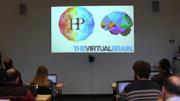Learn TVB the easy way
The Virtual Brain is a big, customizable neuroinformatics platform with tons of features and many use cases.
If you haven't used such a tool before and don't know what data to play with, it might look daunting…
But fear not, we're here to help!
The TVB EduPack is an officially approved and growing list of EduCases – giving you a headstart with video lectures and step-by-step tutorials.
Some of our EduCases come with a research paper as baseline, plus ready-made Python notebooks and even datasets for importing!
Make sure the check out all major TVB-related publications as well!
In our Brainsimulator section, you can find more help & tutorial resources.
Submit your own EduCase
Have you done interesting research using TVB and want to share it as a learning experience?
Your research could be featured here as well!
Your EduCase should contain the following assets:
- Tutorial video, e.g. a lecture you gave (has to be hosted on YouTube)
- Link to your research paper (must be published, not in peer-review anymore)
- optional: iPhython notebook with short walk-through incl. code samples
- optional: Accompanying code, hosted on your own website or GitHub
- optional: set of demo data, hosted on your own website or GitHub
If you provide demo data, please make sure that you have cleared the privacy and usage rights!
Send your EduCase submission info directly to pritter@thevirtualbrain.org for evaluation.
EduCases for The Virtual Brain.
Learning by doing.
-
- Basics
LEARN: Improving Life Through Simulation
-
- Basics
LEARN: Introduction to The Virtual Brain
-
- Basics
LEARN: The Virtual Brain Tutorial
-
- Basics
LEARN: How to interact with the GUI and script interface of TVB
-
- Basics
LEARN: Hands-On: Introduction to the GUI
-
- Basics
LEARN: My first simulation with The Virtual Brain
-
- Basics
LEARN: Neural Masses as Source Models for EEG and MEG
-
- Basics
LEARN: Theoretical foundations and concepts of The Virtual Brain
-
- Basics
LEARN: Inferring multi-scale neural mechanisms with brain network modelling
-
- Basics
LEARN: Population Models in The Virtual Brain (TVB) and the Phase Plane
-
- epilepsy
LEARN: The Local Epileptor: Part 1
-
- epilepsy
LEARN: The Local Epileptor: Part 2
-
- epilepsy
LEARN: The Virtual Epileptic Patient: Part 1
-
- epilepsy
LEARN: The Virtual Epileptic Patient: Part 2
-
- epilepsy
LEARN: Modelling Epilepsy with The Virtual Brain
-
- epilepsy
LEARN: TVB Clinical Applications - Epilepsy
-
- epilepsy
LEARN: Hands-On: Epilepsy & Virtual Mouse Brain
-
- epilepsy
LEARN: Modeling epilepsy with The Virtual Brain (TVB)
-
- epilepsy
LEARN: The Bayesian Virtual Epileptic Patient (BVEP)
-
- Stimulation
LEARN: Brain stimulation in The Virtual Brain
-
- Stimulation
LEARN: Hands-On: Modeling brain stimulation
-
- Stimulation
LEARN: Surface-based simulations and deep brain stimulations
-
- Stroke
LEARN: Modelling Strokes within TVB
-
- Stroke
LEARN: TVB Clinical Applications - Stroke Recovery & Dementia
-
- Stroke
LEARN: Hands-On: Modeling stroke brain
-
- Model construction
LEARN: Human Brain Project (HBP) image processing pipeline for The Virtual Brain
-
- Model construction
LEARN: An automated pipeline for constructing personalized virtual brains from multimodal neuroimaging data
-
- Model construction
LEARN: Import Virtual Brain ready data into TVB and create a brain model
-
- Model construction
LEARN: Generating Virtual Brain ready imaging data
-
- Model construction
LEARN: Integrated workflows: Image processing pipeline
-
- Model construction
LEARN: Automatic TVB model generation workflow
-
- Model construction
LEARN: Constructing personalized models from empirical data
-
- Special applications
LEARN: Linking molecular pathways and large-scale computational modeling to assess candidate disease mechanisms and pharmacodynamics in Alzheimer’s disease
-
- Special applications
LEARN: Modeling brain dynamics in brain tumor patients using The Virtual Brain
-
- Special applications
LEARN: Simulating The Virtual Mouse Brain (TVMB)
-
- Special applications
LEARN: Modeling a virtual macaque brain
-
- Special applications
LEARN: Generate your own 3D brain model outside The Virtual Brain
-
- Special applications
LEARN: Bridging multi-scales in The Virtual Brain (TVB)
-
- Special applications
LEARN: Multi-scale entropy: an abstract measure with clinical application
-
- Advanced simulation
LEARN: Human Brain Project (HBP) TVB-NEST co-simulation
-
- Advanced simulation
LEARN: TVB-NEST co-simulation on local computer
-
- Advanced simulation
LEARN: TVB integrated workflows on EBRAINS
-
- Advanced simulation
LEARN: TVB in the Human Brain Project cloud
-
- Advanced simulation
LEARN: Fast TVB for HPC on EBRAINS
-
- Advanced simulation
LEARN: TVB to NEST multi-scale simulation
-
- Advanced simulation
LEARN: TVB-NEST-Elephant workflow













































